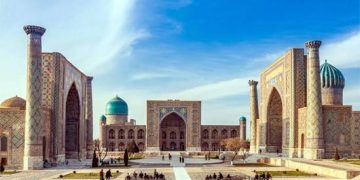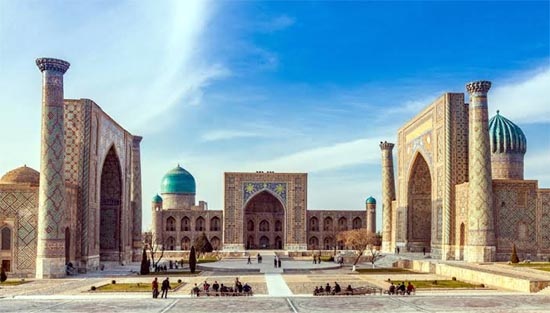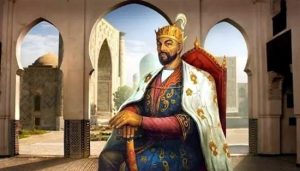Timur, better known in the West as Tamerlane from his nickname Timur-i-leng or “Timur the Lame”, was the last of the great nomadic warriors to sweep out of Central Asia and shake the world. In 1336, at Shakhrisabz in present-day Uzbekistan, the wife of a minor chief of the Mongol Barlas clan gave birth to a son. He was given an appropriate name-Timur means ‘iron’ in Turkish-and raised in the Turkic-Islamic tradition of the surrounding steppe as a rider, archer and swordsman.
Even by the harsh standards of the Mongol hordes, Timur excelled. Before he was twenty years old he had attracted a band of followers with whom he ranged across the steppe raiding caravans and rustling horses. In 1360 his skills as a commander were rewarded when he was recognized as chief of the Barlas clan. Over the next ten years he steadily extended his influence over Transoxiana – the region between the Oxus and Jaxartes (Syr Darya) Rivers centered on present-day Uzbekistan acquiring wounds to his right arm and leg in the process, and hence his nickname. In 1370 he conquered Turkistan, the last surviving Mongol Khanate, and declared himself Amir or “Commander”. He made the Silk Road city of Samarkand his capital, and then embarked on a series of military conquests that rocked Asia and Europe to their very foundations.
In 1371 Emir Timur began the restoration of the destroyed fortress of Samarkand, defensive walls of Shakhristan with six gate Sheykhzada, Akhanin, Feruza, Suzangaran, Karizgakh and Chorsu, and in the arch two four-story buildings were built by Kuksarai in where the state treasury, workshops and prison were settled down and also Bustan-saray in where the residence of the emir was settled down. In these constructions there was an integrated Turk, the Arab, Mongolian and Persian styles. Old places of Samarkand were burned by Mongols, this part is now called Afrasiab (The old Samarkand before Emir Timur), there were archeological excavations.
In days of the campaigns Timur took not only material production, but also brought prominent scientists, handicraftsmen, artists, and architects to the country. The construction of Samarkand and other cities of the East is the most striking example of a symbol of the power of the state of Emir Timur. During the 14th century its new blossoming began, it happened during the board of the grand conqueror Timur who decided to make Samarkand the capital of the empire. Clavijo, the Castalian/ Spanish ambassador at the court of Timur, Samarkand was so fascinated that he wrote about it in his book: “Timur wanted to glorify this city in every possible way”. Timur wanted to make the capital is inaccessible fine and grandiose, surpassing all other cities of the world. Around Samarkand 14 gardens were rustled the biggest of them was so extensive that once (as tell ancient chronicles) the horse of the architect there got lost and it looked for the whole month.
The architectural complex of Samarkand, lasting from Iron Gate to the east in the form of the street, was built up on the parties by smart tombs and cult structures. The historic heart of Samarkand is the Registan, an open square dominated by three great madrassa, or Islamic colleges. George Curzon, later to become Viceroy of India, visited in 1899 and was moved enough to describe the Registan as “the noblest public square in the world”. He continues: “No European spectacle can be adequately compared to it, in our inability to point to an open space in any western city that is commanded on three of its four sides by Gothic cathedrals of the finest order.” The architecture is distinctively Timurid, being characterized by an extraordinarily lavish use of color, especially emerald, azure, deep blue and gold. The great domes are fluted, the vast porticoes richly decorated with corkscrew columns and intricately-patterned glazed tiles. Astonishingly, the façade of the Shir Dor Madrassa on the east side of the square is decorated with half-tiger, half-lion creatures stalking deer, whilst a blazing sun with a human face rises behind the beast of prey’s back.
After the Registan, the monumental Bibi Khanum Mosque is perhaps the most extraordinary sight in the city. Built for Timur’s chief wife, Saray Mulk Khanum, this magnificent building was financed by the plunder brought back from Delhi in 1398; it is said that 95 elephants were used in hauling marble for the mosque. On Bibi Khanum’s completion a chronicler was moved to write: “Its dome would have been unique had it not been for the heavens, and unique would have been its portal had it not been for the Milky Way.” Even so, historians have shown that in his plans for the Bibi Khanum, Timur’s vision exceeded the architectural possibilities of the time. Quite simply, the lofty iwan (portico) and the towering minarets were too ambitious for the technology of the time-especially in a land prone to violent earthquakes. By all accounts, parts of the giant mosque began to collapse within months of its consecration. Today all three massive azure domes have been restored, and work still continues, though this time with ferro-concrete supports hidden behind the elaborate glazed tile work, on the lofty iwan and minarets. When the restoration is complete in around 2002, Uzbekistan will have yet another architectural marvel to draw visitors.
Gur-i Amir, or “Tomb of the Ruler”, Timur’s own last resting place having fabulous structure, which was completed in 1404, is dominated by the octagonal mausoleum and its peerless fluted dome, azure in color, with 64 separate ribs. Within lie the remains not only of Timur, but also of various members of his family, including his grandson the scholar-king Ulugh Beg. Timur’s tomb is protected by a single slab of jade, said to be the largest in the world. Brought back by Ulugh Beg from Mongolia in 1425, it was broken in half in the 18th century by the Persian Ruler Nadir Shah, who tried to remove it from the chamber. Carved into the jade is an inscription in Arabic: “When I rise, the World Will Tremble.”
Emir Timur is said to have been illiterate, but fluent in Turkish and Persian. Sources speak of his sharp wit and hunger for knowledge. He enjoyed playing chess. Above all, he seems to have loved his capital, Samarkand, and he spent much time between campaigns. For 35 years Timur’s forces ranged far and wide, repeatedly sweeping across Central Asia, Iran, Turkey and northern India. In 1405 Timur was preparing his greatest expedition ever, aimed at conquering China, when he was struck down by fever and died. Timur’s most lasting and unlikely legacy remains the unsurpassed architectural jewel(Samarkand) of Central Asia.






